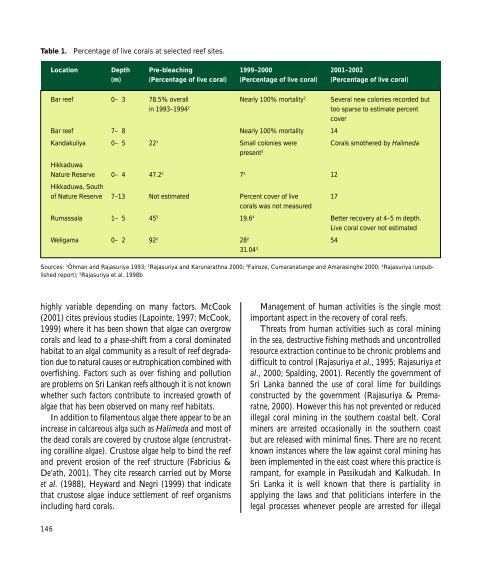Create successful ePaper yourself
Turn your PDF publications into a flip-book with our unique Google optimized e-Paper software.
Table 1.<br />
Percentage of live corals at selected reef sites.<br />
Location Depth Pre-bleaching 1999–2000 2001–2002<br />
(m) (Percentage of live coral) (Percentage of live coral) (Percentage of live coral)<br />
Bar reef 0– 3 78.5% overall Nearly 100% mortality 2 Several new colonies recorded but<br />
in 1993–1994 2<br />
too sparse to estimate percent<br />
cover<br />
Bar reef 7– 8 Nearly 100% mortality 14<br />
Kandakuliya 0– 5 22 1 Small colonies were Corals smothered by Halimeda<br />
present 2<br />
Hikkaduwa<br />
Nature Reserve 0– 4 47.2 2 7 2 12<br />
Hikkaduwa, South<br />
of Nature Reserve 7–13 Not estimated Percent cover of live 17<br />
corals was not measured<br />
Rumassala 1– 5 45 5 19.6 4 Better recovery at 4–5 m depth.<br />
Live coral cover not estimated<br />
Weligama 0– 2 92 2 28 2 54<br />
31.04 3<br />
Sources: 1 Öhman and Rajasuriya 1993; 2 Rajasuriya and Karunarathna 2000; 3 Fairoze, Cumaranatunge and Amarasinghe 2000; 4 Rajasuriya (unpublished<br />
report); 5 Rajasuriya et al. 1998b<br />
highly variable depending on many factors. McCook<br />
(2001) cites previous studies (Lapointe, 1997; McCook,<br />
1999) where it has been shown that algae can overgrow<br />
corals and lead to a phase-shift from a coral dominated<br />
habitat to an algal community as a result of reef degradation<br />
due to natural causes or eutrophication combined with<br />
overfishing. Factors such as over fishing and pollution<br />
are problems on Sri Lankan reefs although it is not known<br />
whether such factors contribute to increased growth of<br />
algae that has been observed on many reef habitats.<br />
In addition to filamentous algae there appear to be an<br />
increase in calcareous alga such as Halimeda and most of<br />
the dead corals are covered by crustose algae (encrustrating<br />
coralline algae). Crustose algae help to bind the reef<br />
and prevent erosion of the reef structure (Fabricius &<br />
De’ath, 2001). They cite research carried out by Morse<br />
et al. (1988), Heyward and Negri (1999) that indicate<br />
that crustose algae induce settlement of reef organisms<br />
including hard corals.<br />
Management of human activities is the single most<br />
important aspect in the recovery of coral reefs.<br />
Threats from human activities such as coral mining<br />
in the sea, destructive fishing methods and uncontrolled<br />
resource extraction continue to be chronic problems and<br />
difficult to control (Rajasuriya et al., 1995; Rajasuriya et<br />
al., 2000; Spalding, 2001). Recently the government of<br />
Sri Lanka banned the use of coral lime for buildings<br />
constructed by the government (Rajasuriya & Premaratne,<br />
2000). However this has not prevented or reduced<br />
illegal coral mining in the southern coastal belt. Coral<br />
miners are arrested occasionally in the southern coast<br />
but are released with minimal fines. There are no recent<br />
known instances where the law against coral mining has<br />
been implemented in the east coast where this practice is<br />
rampant, for example in Passikudah and Kalkudah. In<br />
Sri Lanka it is well known that there is partiality in<br />
applying the laws and that politicians interfere in the<br />
legal processes whenever people are arrested for illegal<br />
146


















